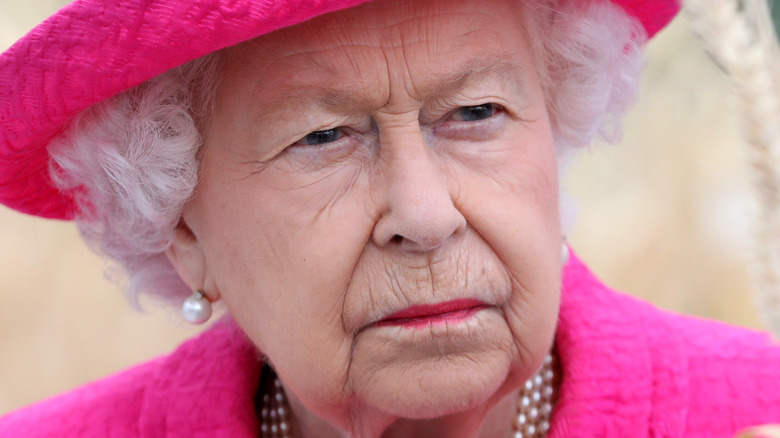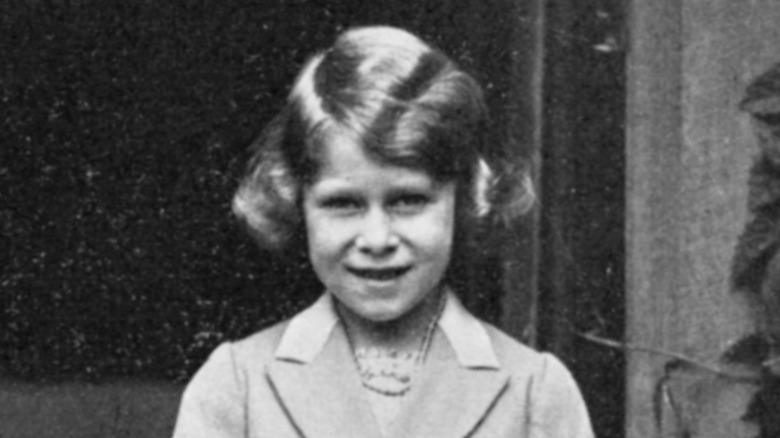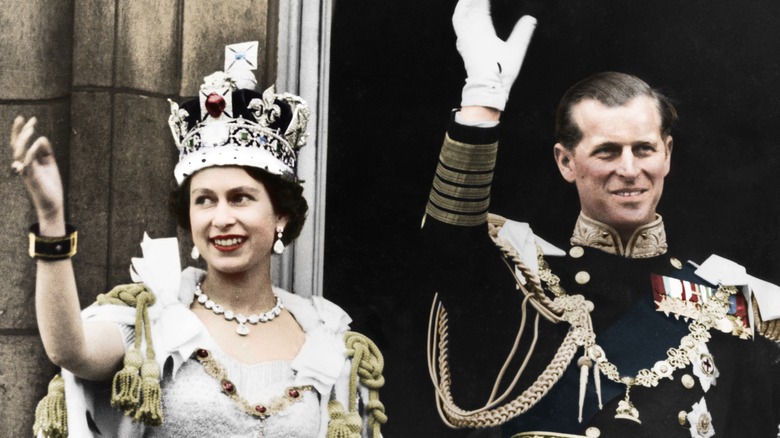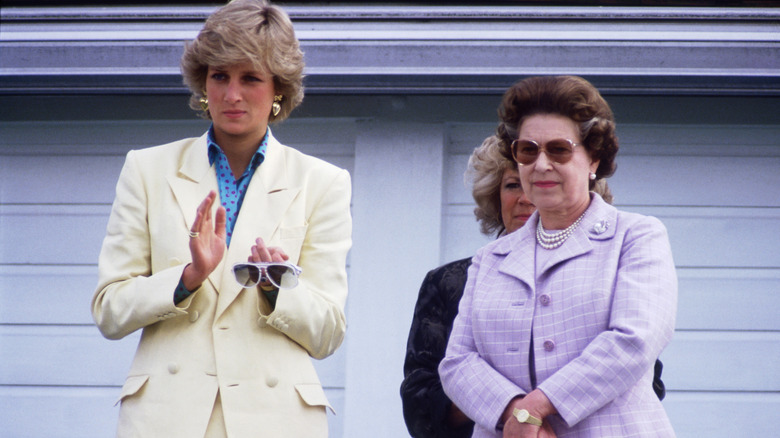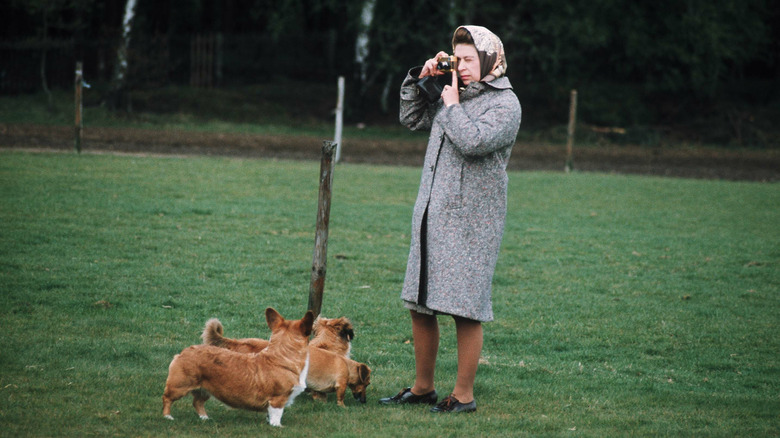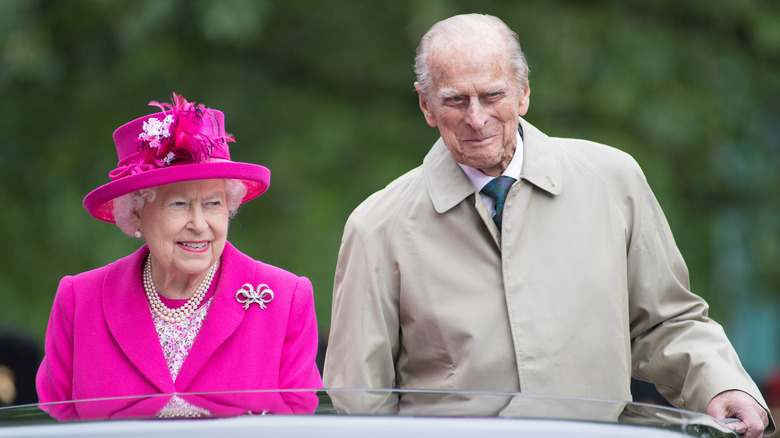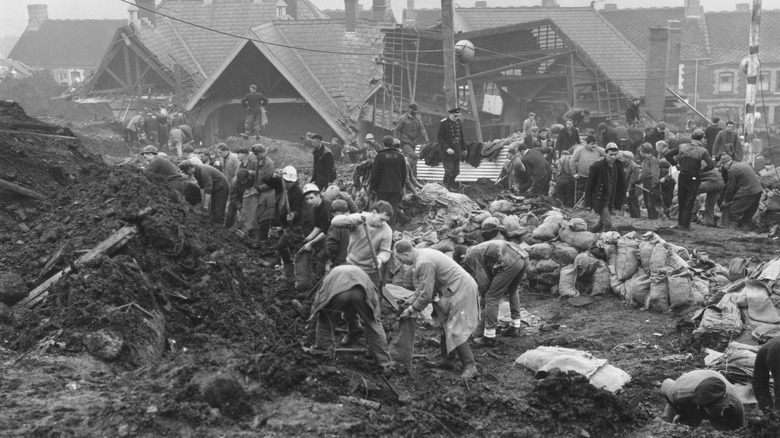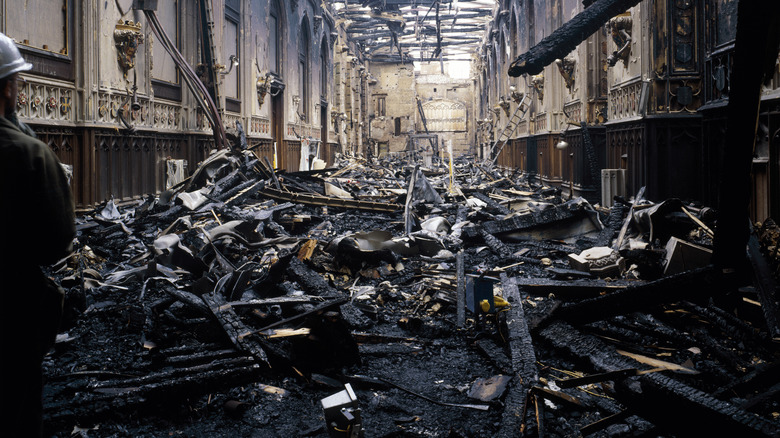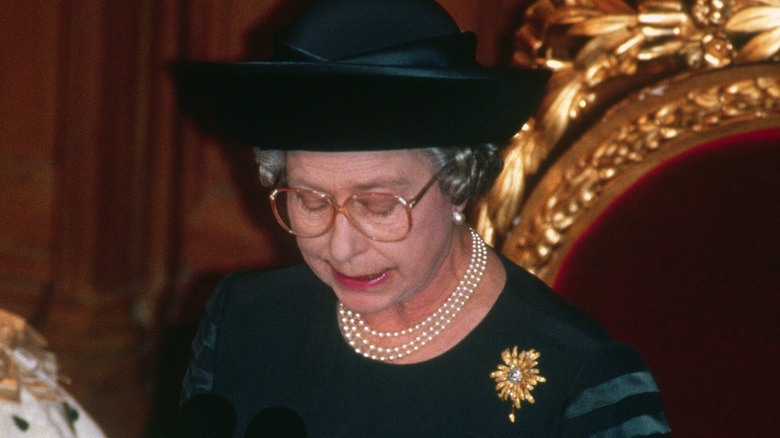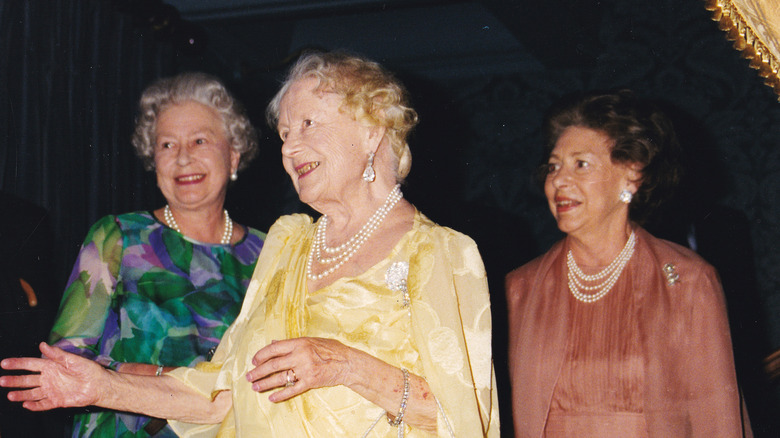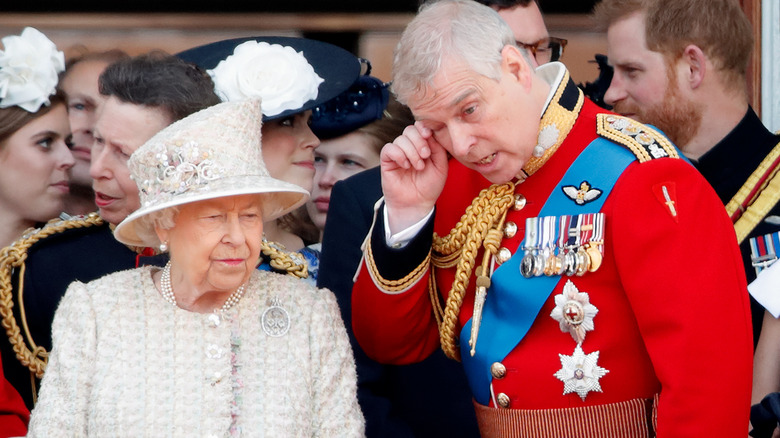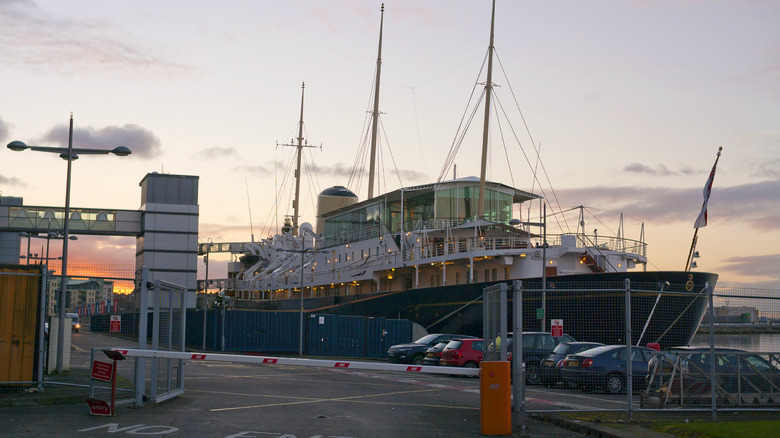The Tragic Real-Life Story Of Queen Elizabeth
The late queen of the United Kingdom of Great Britain and Northern Ireland was actually the second of her name — the original Queen Elizabeth was a member of the House of Tudor, and presided over the Elizabethan Age of 1558-1603, per the Royal Family's official website. Still, even that lengthy reign can't hold a torch to Queen Elizabeth II. She came to the throne on February 6, 1952, and her seven-decade tenure makes her by far the longest-reigning monarch in the history of British royals (via Encyclopedia Britannica).
If a person spends enough time in a high-profile job and their entire family is constantly in the limelight, it's likely that things won't be smooth sailing. Her Majesty's life and reign being as long as they were, she saw more than her share of turmoil over the decades, and some of the tragedies she had to go through were truly terrifying. Let's take a look at some of the worst burdens she had to shoulder over the years. This is the tragic real-life story of Queen Elizabeth II.
A single year changed young Princess Elizabeth's life completely
Per Encyclopedia Britannica, Queen Elizabeth II reigned from February 6, 1952 to September 8, 2022. That's a long, long time, and unless you're old enough and were keeping tabs on the British royalty before that, it's impossible to even remember an era before she was sitting on the throne. However, her becoming a queen was far from a sure thing. According to Time, Princess Elizabeth was actually third in the line of succession, and was already well on her way toward a nice life largely out of the public eye — something that might not have been unwelcome, since she was reportedly a fairly shy person (via Marie Claire).
However, events conspired to steer her away from relative seclusion. When King George V died in 1936, his primary successor was King Edward VIII, who left the throne before the end of the year due to his relationship with commoner Wallis Simpson. As such, Elizabeth's father and King George V's second-youngest son — Albert, the Duke of York — was forced to step up as King George VI. This, in turn, meant that she would one day succeed him.
The stuttering, private George VI disliked the idea of being a king, and shy, young Elizabeth now found herself the center of the kingdom's attention. Within the course of one year, she lost her beloved grandfather, and her life and future were permanently upended.
Her ascension to the throne meant the death of her father
The thing about kings and queens is that they only get the crown after the current incumbent either steps down or dies. As Time tells us, this means that Princess Elizabeth became the queen after the death of her father. King George VI suffered from significant health problems, and died on February 6, 1952, at only 56 years old.
The 25-year-old Elizabeth and her husband, Prince Philip, had just embarked on a series of international visits and were in Kenya when the news reached them. Just like that, and long before the couple had expected, young Elizabeth was Her Majesty the Queen.
Both Elizabeth and Philip took the news hard. Navy man Philip didn't much care for the demands of his newfound role as the queen's husband, which required relocating to Buckingham Palace and essentially destroyed his own career prospects. According to The Guardian, the news was pretty hard on Elizabeth, as well. She managed to keep up appearances until she boarded the plane that would take them back to Britain. In the plane, she remained calm ... but fellow passengers reportedly couldn't help noticing that at one point, she locked herself in the plane's bathroom to weep in peace.
Princess Diana's death spelled trouble for the queen
One of the biggest crises the British monarchy faced during the reign of Queen Elizabeth II was the aftermath of Princess Diana's death, according to ABC News. The heartbreaking death of Princess Diana happened on August 31, 1997 (via People), when a car carrying her and Dodi Al-Fayed crashed in the middle of the Pont de l'Alma tunnel. The accident killed the couple and their driver, and prompted a number of conspiracy theories about Princess Diana's death.
"Someone must have greased the brakes," the queen is said to have initially quipped while under the impression that Diana was merely mildly injured. When the true nature of tragedy eventually dawned, she was quick to make arrangements and shelter Diana's sons, Prince William and Prince Harry, from the barrage of impeding news. She also decided to stay with them at Balmoral Castle, prioritizing the family over public relations despite pressure to do otherwise (per the Mirror).
Unfortunately, this means she failed to address the situation to the public. Diana had recently divorced Prince Charles, and her relationship with the royal family wasn't amazing, but the people still loved the princess — and when Queen Elizabeth II said nothing, the public turned against her, and the media was throwing fuel on the flames. In a matter of days, the future of the crown was hanging in balance. Queen Elizabeth II ultimately managed to undo some of the damage with a heartfelt and personal televised speech, but tensions lingered on.
The queen has lost so, so many pets
Queen Elizabeth II was so famous for her love of corgi dogs that there's even an animated movie called "The Queen's Corgi" (via IMDb). Per the BBC, the queen's family had corgis when she was a child, and she got her own dog, Susan, when she turned 18.
Susan is obviously long dead and rests under a gravestone that her owner designed personally. Since then, Queen Elizabeth II owned more than 30 pups of the same breed. The last one of them, unfortunately, died in 2018, which means that she had also lost over 30 dogs. The monarch stopped breeding pure corgis in 2015 but nevertheless remained in the dog game. By the time of her death in 2022, she owned two corgis, a dachshund-corgi mix known as "dorgi," and a cocker spaniel (via Mirror).
The queen's corgi game was usually treated as a private matter, but if you think that a monarch with a whole bunch of dogs is too high and mighty to mourn the death of one, well, that's not exactly the case. Per Vanity Fair, Queen Elizabeth II was absolutely grief-stricken when one of her dorgis died in 2021.
Prince Philip's death in 2021 was a hard blow
On April 9, 2021, Prince Philip, Duke of Edinburgh, died at Windsor Castle, per the BBC. The queen's husband was 99 years old. The news arrived in the form of a statement from Buckingham Palace. "It is with deep sorrow that Her Majesty The Queen announces the death of her beloved husband," it read. "The Royal Family join with people around the world in mourning his loss."
As The Guardian tells us, Queen Elizabeth II and Prince Philip were married for 73 years, though Philip was quite reluctant to step into the highly restrictive life of a Queen's consort (via Time), as well as the fact that he would be a part of Elizabeth's House of Windsor. Nevertheless, he stood faithfully by the queen's side, and per The Guardian, Elizabeth was indeed distraught by the loss of the man she could count on for such a long time.
According to ABC News, she turned 95 just weeks after Philip's demise and addressed her grief in her birthday statement. "While as a family we are in a period of great sadness, it has been a comfort to us all to see and to hear the tributes paid to my husband, from those within the United Kingdom, the Commonwealth, and around the world," she said.
The Aberfan disaster was a hard lesson
In October 1966, a terrifying disaster in Aberfan, Wales sent a massive amount of coal waste from a local mine running down a hill, covering the village below and killing 144 people (via History). Tragically, 116 of the victims were children, per Town & Country Mag. They were at school when the rain-soaked waste — which had been stored above the village despite the risk it posed — came down like a landslide.
As the frantic rescue attempts to dig out possible survivors from the coal sludge went on, Queen Elizabeth II stayed oddly silent about the situation. Per biographer Sally Bechdel Smith, the queen had good intentions for her silence, as she didn't want to divert attention from the rescue operation. She eventually sent Prince Philip to visit the site, and ultimately decided to go herself — eight days after the fact. When she finally arrived, she was extremely disturbed to see the reality of the situation, and regretted her slow reaction time ever since.
The queen may have ranked Aberfan among her greater failings, but people who were actually there think otherwise. "If the queen does regret not coming here straight away, I think that is misplaced," one survivor told the South Wales Echo. "When she did arrive she was visibly upset and the people of Aberfan appreciated her being here. She came when she could and nobody would condemn her for not coming earlier, especially as everything was such a mess."
The Windsor Castle fire forced her to make difficult financial decisions
On November 20, 1992, Windsor Castle — one of the queen's residences — took massive damage in a devastating fire (via Windsor Castle's official website). The castle is a massive and well-equipped site that usually has its own fire brigade, but as misfortune would have it, the fire started during renovations and fire alarms weren't working. As a result, the flames that began when a spotlight started a blaze that took 15 hours to extinguish, and caused $47.5 million in damages that took five years to fix (via People). The queen was obviously alarmed when she learned of the situation, and arrived on the scene when flames were still raging.
Incredibly, the aftermath of the tragedy was arguably even fierier than the incident itself. Per The Hour, the castle — like other similar properties — was so valuable that insurance companies wouldn't touch it with a five-mile pole, and the initial impression was that the government would pay for fixing it. However, subsequent discussions called attention to the significant costs of maintaining the royal family. In the end, the queen agreed to finance 70% of the restoration herself. She also started paying income taxes, and began placing restrictions on the way the government financed members of the royal family (via the BBC).
1992 was a horrible year for her
Per the Royal Family's official website, Queen Elizabeth II referred to the year 1992 as "annus horribilis," Latin for the terrible year. "1992 is not a year on which I shall look back with undiluted pleasure," she said in a speech during the 40th anniversary of her reign. This was due to several incidents, including a devastating fire at Windsor Castle.
The main theme of 1992, however, was a vast array of royal PR disasters that kept piling up. According to the Los Angeles Times, the scandals that shook the monarchy that year included the divorce of the queen's daughter, Princess Anne. It was also clear that the same fate was awaiting Prince Charles and Princess Diana, thanks to the scandalous book "Diana – Her True Story," which the princess herself had secretly collaborated with the author on (via The New York Times). Somehow, all of this wasn't enough, and Prince Andrew's marriage to Duchess Sarah — aka Fergie — was also in dire straits after compromising poolside photographs of her and her financial manager surfaced (via The Guardian).
With three of her four children embroiled in public scandals of varying severity, it's no surprise that the queen had no particular love for the year 1992, and she also made clear that she considered the media attention rather too harsh. "I dare say that history will take a slightly more moderate view than that of some contemporary commentators," she said.
She lost multiple family members in 2002
Losing your parent or sibling is hard, but losing both within a few weeks of each other is a whole other level of loss. Unfortunately for Queen Elizabeth II, she had to go through this in 2002, when her sister died on February 9 (via the Royal Family's website) — and her mother passed away soon afterwards (via People).
Queen Elizabeth II released a statement shortly after Princess Margaret died, revealing that she'd experienced a stroke and passed away at the King Edward VII Hospital. Per People, 71-year-old Margaret had health issues for a while before her death. She was a much wilder and more social person than the reserved queen, but despite the princess' glamorous lifestyle and the pair's occasionally turbulent relationship when they were younger, they were close (via Marie Claire).
The queen didn't have too long to grieve — or rather, she soon had to do it doubly as much. On May 30, she lost another close relative when her mother, 101-year-old Queen Elizabeth, died. The Queen Mother was a beloved member of the royal family, and before her funeral, Queen Elizabeth II gave a rare speech in which she praised her mother. "Over the years, I have met many people who have had to cope with family loss, sometimes in the most tragic of circumstances," she said. "So I count myself fortunate that my mother was blessed with a long and happy life."
She stripped Prince Andrew of his ranks and privileges after a major scandal
On January 13, 2022, there was one fewer working royal in the world. This is when the Royal Family's official Twitter account posted a message that was very bad news to Queen Elizabeth II's son, Prince Andrew. "With The Queen's approval and agreement, The Duke of York's military affiliations and Royal patronages have been returned to the Queen. The Duke of York will continue not to undertake any public duties and is defending this case as a private citizen."
What case was that referring to? Per CNBC, the queen felt forced to take the drastic measure of stripping Prince Andrew of his various privileges — as well as his official right to use the "His Royal Highness" honorific — because he was facing a court case regarding his alleged involvement in the long-running Jeffrey Epstein and Ghislaine Maxwell child sex trafficking case. This happened after considerable public pressure. Per Town & Country, Andrew settled the case in February 2022 but has stayed well out of the spotlight since.
If you or anyone you know has been a victim of sexual assault, help is available. Visit the Rape, Abuse & Incest National Network website or contact RAINN's National Helpline at 1-800-656-HOPE (4673).
She lost her beloved royal yacht
On December 11, 1997, a peculiar scene took place when Queen Elizabeth II was seen crying during the sendoff ceremony to a yacht (via The Guardian). In all fairness, this wasn't just any old vessel. The royal family had a long tradition of owning their personal yachts — ever since the HMY Royal Escape in 1660, in fact.
The decommissioned ship was the latest and last in this line, known as the Royal Yacht Britannia. The ship was in service since 1953, and its official website reveals that it acted as a comfortable home away from home for the Queen and her family — both in official functions and private escapades. It was likely important to Queen Elizabeth II not only because she spent so much time aboard it, but also because she and Prince Philip had a hand in its design. "All the other places we live in had been built by predecessors," Prince Philip said about Royal Yacht Britannia.
These days, the yacht that used to be so important to the Queen that she openly wept when she had to let it go is docked in Edinburgh, Scotland, where it serves as a tourist attraction, hotel, and event venue.
